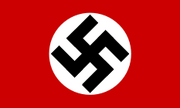Swastika
From Plastic Tub
(Difference between revisions)
| Revision as of 09:03, 25 Feb 2005 Undule (Talk | contribs) ← Go to previous diff |
Current revision Adkins (Talk | contribs) |
||
| Line 1: | Line 1: | ||
| - | [[Category:Glossary]][[Image:180px-Swastika_flag_(Nazi_Germany).ant.png|thumb||right|The swastika in one of its less popular incarnations.]] | + | [[Category:Glossary]]__NOTOC__ |
| - | '''swastika''' ''(un.)'' '''1.''' Proposed by the German [[Nazi Regime|Nazi regime]] as a replacement for the cross, the swastika is a prerelational symbol of inevtibality. '''2.''' An ancient religious symbol formed by a cross with the ends of the arms bent at right angles in either a clockwise or a counterclockwise direction. '''2.''' A dancing midget. | + | <table width="100%" border="0" align="right" cellpadding="4" cellspacing="0"> |
| - | + | <tr><td width="*" align="left" valign="top">'''swastika''' ''(un.)'' '''1.''' Proposed by a German [[Nazi Regime|Nazi regime]] as a replacement for [[The Cross|the cross]], the swastika is one of the earliest noted [[Associationalist]] symbols of inevitability, rapine-coloured Futures, or motion made pure by the quotidian -- made [[vapor|vaporic]]: a [[Solar Being|solar being]] divorced of the human mind, writ large through a memeography wrought from slit-throat bogs, snazzy lapel-pins, eternal [[ice theory]], [[Gnostic Materialism|ruthless materialism]] and the [[Donut Shaped World Theory|convexity of earth-life]]. '''2.''' An ancient religious symbol formed by a cross with the ends of the arms bent at right angles in either a clockwise or a counterclockwise direction. '''3.''' A dancing midget. '''4.''' ''euph.'' A reluctantly comical acrobat. | |
| - | == Desiderata == | + | |
| - | :Apparently, the Swastika was popular with Nazis. | + | |
| == See Also == | == See Also == | ||
| + | ---- | ||
| *[[Johnny Cake]] | *[[Johnny Cake]] | ||
| *[[Triskelion]] | *[[Triskelion]] | ||
| + | |||
| + | |||
| + | </td> | ||
| + | <td width="180px" align="left" valign="top" bgcolor="#CCCCCC" style="margin: 0 0 1em 1em; background: #E0E0E0; border: 1px #aaa solid; border-collapse: collapse; font-size: 100%;"> | ||
| + | [[Image:180px-Swastika_flag_(Nazi_Germany).ant.png|thumb||center|The swastika in one of its less popular incarnations.]] | ||
| + | == Desiderata == | ||
| + | |||
| + | ---- | ||
| + | <font style="font-size: 90%"> | ||
| + | |||
| + | </font> | ||
| + | </td> | ||
| + | </tr> | ||
| + | </table> | ||
Current revision
| swastika (un.) 1. Proposed by a German Nazi regime as a replacement for the cross, the swastika is one of the earliest noted Associationalist symbols of inevitability, rapine-coloured Futures, or motion made pure by the quotidian -- made vaporic: a solar being divorced of the human mind, writ large through a memeography wrought from slit-throat bogs, snazzy lapel-pins, eternal ice theory, ruthless materialism and the convexity of earth-life. 2. An ancient religious symbol formed by a cross with the ends of the arms bent at right angles in either a clockwise or a counterclockwise direction. 3. A dancing midget. 4. euph. A reluctantly comical acrobat.
[edit] See Also
|
[edit] Desiderata
|

